The Black Jack Battlefield
Tour Stop
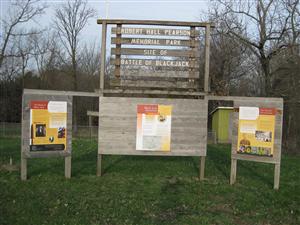
- Return to US Highway 56 and turn left heading west.
- Take the first left (south) onto E 2000 Road.
- The entrance to Black Jack Battlefield will be about 0.2 miles ahead on your right.
Description: You are standing about 100 yards northeast of where fighting occurred on June 2, 1856 between free-state supporters led by John Brown and pro-slavery supporters led by Henry Clay Pate. Be sure to stop at the covered picnic area and pick up a couple of brochures. One of the brochures is a self-guided tour of the battlefield. The self-guided tour is provided by The Black Jack Battlefield Trust.
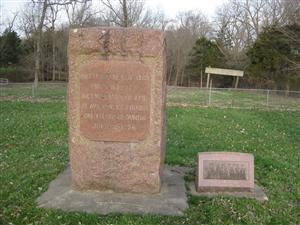
“First Battle between Free and Slave States fought on these grounds June 2, 1856”
Just a little to your right are three interpretive signs [ Waypoint = N38 45.842 W95 07.855 ] about the Robert Hall Pearson Memorial Park and the Battle of Black Jack.
The 'Battle of Black Jack' interpretive sign on the left has text which reads as follows:
“Civil War in Kansas!”
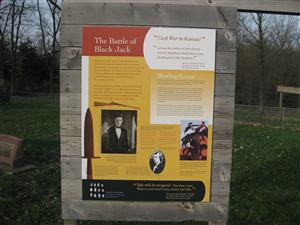
Squatter Sovereign, proslavery newspaper in Atchison, Kansas Territory, June 10, 1856
On this site at dawn on June 2, 1856, the abolitionist John Brown led a free-state militia, with co-commander Samuel Shore, in attacking the camp of a proslavery force led by Henry Clay Pate. The clash was the first pitched battle between proslavery and antislavery groups and is considered by some to been the first battle of the Civil War.
The men on both sides, probably totaling around 90 to 100 individuals, engaged in intense fighting for several hours in the ravines and tall grass of the site. In the end no one was killed. Pate, thinking he was outnumbered and possibly surrounded, eventually surrendered to John Brown.
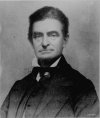 John Brown led the antislavery militia at the battle of Black Jack. A tireless foe of slavery, Brown had come to Kansas Territory in 1855 with several grown sons and other relatives to work for the cause. Following his later attempts to incite a slave rebellion in Virginia, Brown was hanged for treason in 1859.
John Brown led the antislavery militia at the battle of Black Jack. A tireless foe of slavery, Brown had come to Kansas Territory in 1855 with several grown sons and other relatives to work for the cause. Following his later attempts to incite a slave rebellion in Virginia, Brown was hanged for treason in 1859.
Brown kept Pate's bowie knife as a battle trophy after the surrender at Black Jack. Brown later showed the knife to a Connecticut blacksmith, to use as a pattern for making 1000 similar blades to be mounted on poles. These were the famous pikes that Brown hoped to arm a slave rebellion after his 1859 raid on Harper's Ferry.
Henry Clay Pate led the proslavery men at Black Jack. The son of a slaveholding family in Bedford County, Virginia, Pate had come west to promote the proslavery cause in Kansas Territory. He was later killed while fighting for the Confederacy at the Battle of Yellow Tavern near Richmond in May 1864.
Bleeding Kansas
As settlers moved westward in the years before the Civil War, the debate over slavery grew. Would slavery be allowed in the new states coming into the Union? In 1854, the newly-formed Kansas Territory became a focus of the issue.
Proslavery and antislavery backers poured into the area. Feelings ran high, and political conflict soon became violent. Citizens on both sides of the slavery issue formed free-wheeling militias. Several incidents in the spring of 1856 brought matters to a head. Proslavery men sacked the city of Lawrence, an antislavery stronghold. John Brown's men carried out the bloody night-time murder of several proslavery men at the "Pottawatomie Massacre". Henry Clay Pate and his proslavery militia then came looking for Brown. The result was the Battle of Black Jack.
The exact extent of the battle site is uncertain, but evidence indicates the point of land between the ravines to your left was the center of the action and the probable location of Pate's surrender. Visitors may cross the bridge and walk around the battlefield area. The older wooden signs were placed there in the 1960's. They are based on the memories of Samuel Shore, who fought here with John Brown. He returned in 1911 and pointed out the locations of particular incidents in the battle.
Reports of the clash at Black Jack soon appeared in newspapers in Kansas Territory and across the nation. Brown himself wrote an account for the New York Tribune, July 11, 1856.
“Had I known whom I was fighting I would not have trusted a flag of truce. captain Brown commanded me to order my company to lay down their arms. Putting a revolver to my breast he repeated the command, giving me one or two minuted to make the order”
Henry Clay Pate on John Brown on the Battle of Black Jack, New York Tribune, June 15, 1856
“Captain Pate reproaches me with the most dishonorable violations of the rights secured under a flag of truce, but says: My object was to gain time, and if possible have hostilities suspended for awhile." So much, in his own language, for good faith, of which he found me so destitute.” John Brown writing from Lawrence, Kansas Territory, July 1,1856, to the New York Tribune,July 10, 1856.
Jacob Lawrence, a 20th Century artist, painted several series depicting people and places in African American history. This painting of the Battle of Black Jack was part of his John Brown series, completed in 1941.
The Battle of Black jack, although forgotten by many, has lived on as a symbol of the conflict over slavery that led to the national Civil War in 1861.
“Talk will do no good. That time is past. What we now need is men, money and rifles.”
Free-state settler Charles A Wright, in a letter written from Lawrence, Kansas Territory, June 16, 1856.
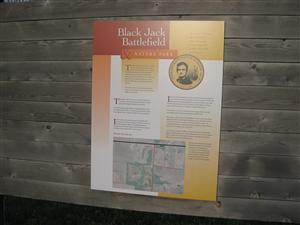
The land you see before you has stories to tell - - - stories of the struggle for human rights and freedoms, stories of the western frontier.
The Battle of Black Jack, fought on this site on June 2, 1856, is considered by many to have been the first battle of the American Civil War. When Kansas Territory opened for settlement in 1854, it was quickly flooded with proslavery and free-state settlers. These opposing groups jostled for political dominance over the issue of whether slavery should be allowed in the Territory.
This land also reflects the process of whits settlement on the frontier. Settlers pushing westward displaced native people and reshaped the natural environment.
The Santa Fe Trail, a major highway for shipping goods between the United States and Mexico, crossed the prairie nearby. Wagon drivers paused here to camp and to water their oxen and mules.
In the late 1800's this land became part of the Robert hall Pearson farm. Pearson had fought in the Battle of Black Jack and later bought acreage here, including the battle site: Like many frontier settlers, Pearson lived on the land and farmed it, raising livestock and growing a variety of crops.
In the face of rapid residential development, concerned individuals bought this 40-acre tract in 2003 to preserve historic areas and green space. The Black Jack Battlefield Trust, a non profit organization, assumed ownership in June, 2004. The battlefield site is listed on both the National and State Registers of Historic Places. The Pearson farm is on the Register of Historic Kansas Places.
The Trust plans over the next several years to place signage, exhibits and other visitor facilities within the Black Jack Battlefield and Nature Park.
Plans call for a visitor center near the battlefield site. Indoor exhibits and outdoor signage will tell the story of the Battle of Black Jack as part of the history of Kansas Territory and the American Civil War. The farmhouse will be restored to its original 1880s appearance. Exhibits and educational programs will help visitors to experience the workings of a 19th century farm.
The Trust is also working to establish a network of nature trails with interpretive signage throughout the property. Visitors walking the trails can enjoy the outdoors, observe wildlife and learn about prairie ecosystems, including a 15 acre restored tallgrass prairie area south of the park.
The site is a star attraction in the recently established Freedom's Frontier National Heritage Area. The Heritage Area, overseen by the National Park Service, is an affiliation of attractions in eastern Kansas and western Missouri that are related to the historical theme of the struggle over slavery and human rights.
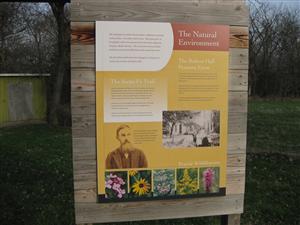
The landscape in northeast Kansas before settlement was mostly treeless prairie, crossed by small streams. Short grass grew on the uplands, while areas around the rivers and streams supported tall grass, shrubs and trees. This site became known as Black Jack because of a stand of Black Jack oaks around the ravines.
The look of the land here has been changed over the past two centuries by travelers and settlers alike.
The Santa Fe Trail
American citizens were not allowed to settle in this area until the creation of the Kansas Territory in 1854. This site had already been affected, however, by years of heavy freight traffic along the nearby Santa Fe Trail. This major trade route running between Westport (now Kansas City) and Santa Fe, in Mexico (now New Mexico) had been opened in 1821.
Caravans of 50 or 60 large freight wagons traveled the trail. The natural spring and streams on this site made it a favored campground and watering spot along the trail.
Tracks across the nearer of the two ravines are believed to have been formed by years of wagon traffic into this watering place and campsite.
The Robert Hall Pearson Farm
To your left, beyond the picnic shelter, are several rows of trees. These are sugar maples, planted by Robert hall Pearson. Pearson had fought beside Brown at Black Jack and later returned to purchase land for his home and farm.
Like many early farmers in northeast Kansas, Pearson experimented with specialty crops. This is believed to be the only site in Kansas where maple sugar was produced. The farm also produced orchard crops, grain and livestock.
The Pearson farmstead, including a frame house built around 1890, stands on a hilltop to the south, overlooking the battlefield.
Robert Hall Pearson, a native of England, grew up in Pennsylvania. He came to Kansas in 1854 as a settler and antislavery advocate. Pearson settled on this farm around 1860 and farmed here until his death in 1906.
Erected 2009 by The Black Jack Battlefield Trust.
